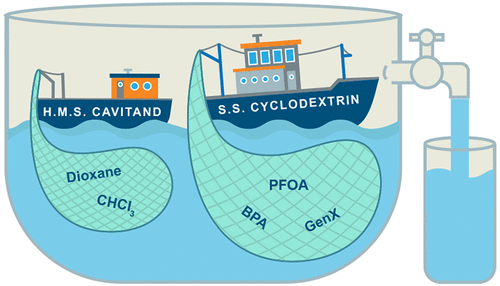当前位置:
X-MOL 学术
›
Acc. Chem. Res.
›
论文详情
Our official English website, www.x-mol.net, welcomes your feedback! (Note: you will need to create a separate account there.)
Polymerized Molecular Receptors as Adsorbents to Remove Micropollutants from Water.
Accounts of Chemical Research ( IF 18.3 ) Pub Date : 2020-09-15 , DOI: 10.1021/acs.accounts.0c00426 Max J Klemes 1 , Luke P Skala 1 , Mohamed Ateia 1 , Brittany Trang 1 , Damian E Helbling 2 , William R Dichtel 1
Accounts of Chemical Research ( IF 18.3 ) Pub Date : 2020-09-15 , DOI: 10.1021/acs.accounts.0c00426 Max J Klemes 1 , Luke P Skala 1 , Mohamed Ateia 1 , Brittany Trang 1 , Damian E Helbling 2 , William R Dichtel 1
Affiliation

|
Organic micropollutants (MPs) are increasing in number and concentration in water systems as a result of human activities. Often from human origin, these micropollutants build up in the environment because organisms lack the mechanisms to metabolize these substances, which cause negative health, ecological, and economic effects. Adsorption-based remediation processes for these compounds often rely on activated carbon materials. However, activated carbons are ineffective against certain MPs, exhibit low removal efficiencies in the presence of common aqueous matrix constituents, and require energy-intensive activation and regeneration processes. To overcome the deficiencies of traditional technologies, novel adsorbents based on molecular receptors offer promising alternative solutions. This Account describes the recent development of polymer adsorbents based on molecular receptors for removing trace organic chemicals from water. Polymer networks based on molecular receptors have high binding affinities for many MPs but, unlike activated carbons, have a specific molecule-binding mechanism that prevents these polymers from being fouled by matrix constituents such as natural organic matter. The size and hydrophobic pocket of the β-cyclodextrin receptor preferentially adsorbs target molecules such as organic micropollutants in the presence of matrix constituents, and the nature of the cross-linker tunes the binding affinity and selectivity of the adsorbent for specific classes of MPs, including those of varying charge and hydrophobicity. β-cyclodextrin polymers also exhibit rapid adsorption kinetics and are easily regenerated. This Account details β-cyclodextrin polymers made with three different cross-linkers, including a polymer that is postsynthetically transformed from a negatively charged polymer to a positively charged polymer to invert the polymer’s micropollutant adsorption profile. Morphological constraints have so far limited these cross-linked polymers’ ability to be used in commercial applications, but two methods to create larger and more uniformly sized particles for use in flow-through applications are described here. β-Cyclodextrin polymers are useful for trapping organic micropollutants such as bisphenol A, perfluorooctanoic acid, and many kinds of pharmaceuticals and pesticides, but their binding pockets are too large to capture micropollutants that are small or of high polarity. Other molecular receptors such as resorcinarene cavitands can target lower-molecular-weight MPs, including halomethane disinfection byproducts and industrial solvents, that are not bound strongly by β-cyclodextrins. These materials demonstrate the potential of expanding the library of polymers based on molecular receptors. Overall, these emerging adsorbents show promise for the removal of legacy and emerging MPs from water, as well as the ability to rationally tune the adsorbent’s structure to target the most persistent and toxic MPs.
中文翻译:

聚合的分子受体作为吸附剂,可从水中去除微量污染物。
由于人类活动,有机微污染物(MPs)在水系统中的数量和浓度正在增加。这些微量污染物通常来自人类,会在环境中积聚,因为生物体缺乏代谢这些物质的机制,这会对健康,生态和经济产生负面影响。这些化合物的基于吸附的修复方法通常依赖于活性炭材料。但是,活性炭对某些MP无效,在常见的水性基质成分存在下去除效率低,并且需要耗费大量能量的活化和再生过程。为了克服传统技术的不足,基于分子受体的新型吸附剂提供了有希望的替代解决方案。该帐户描述了基于分子受体的聚合物吸附剂的最新进展,该聚合物吸附剂用于从水中去除痕量有机化学物质。基于分子受体的聚合物网络对许多MP具有很高的结合亲和力,但与活性炭不同,它具有特定的分子结合机制,可防止这些聚合物被基质成分(例如天然有机物)污染。在基质成分存在的情况下,β-环糊精受体的大小和疏水口袋优先吸附目标分子,例如有机微污染物,并且交联剂的性质可调节吸附剂对特定类别MP的结合亲和力和选择性,包括那些电荷和疏水性不同的化合物。β-环糊精聚合物还表现出快速的吸附动力学,并且易于再生。该帐户详细介绍了由三种不同的交联剂制成的β-环糊精聚合物,包括一种聚合物,该聚合物从带负电荷的聚合物后合成后转变为带正电荷的聚合物,从而颠倒了聚合物的微污染物吸附特性。迄今为止,形态学限制已经限制了这些交联聚合物在商业应用中的使用能力,但是这里描述了两种用于产生较大和更均匀尺寸的颗粒用于流通应用的方法。β-环糊精聚合物可用于捕集有机微污染物,例如双酚A,全氟辛酸以及许多药物和农药,但它们的结合口袋太大,无法捕获小的或极性高的微污染物。其他分子受体(例如间苯二甲烯空洞体)可以靶向较低分子量的MP,包括不受β-环糊精牢固结合的卤甲烷消毒副产物和工业溶剂。这些材料证明了扩展基于分子受体的聚合物库的潜力。总体而言,这些新兴的吸附剂显示出有望从水中去除残留的和新兴的MP的能力,以及合理调整吸附剂结构以针对最持久和毒性最大的MP的能力。
更新日期:2020-10-21
中文翻译:

聚合的分子受体作为吸附剂,可从水中去除微量污染物。
由于人类活动,有机微污染物(MPs)在水系统中的数量和浓度正在增加。这些微量污染物通常来自人类,会在环境中积聚,因为生物体缺乏代谢这些物质的机制,这会对健康,生态和经济产生负面影响。这些化合物的基于吸附的修复方法通常依赖于活性炭材料。但是,活性炭对某些MP无效,在常见的水性基质成分存在下去除效率低,并且需要耗费大量能量的活化和再生过程。为了克服传统技术的不足,基于分子受体的新型吸附剂提供了有希望的替代解决方案。该帐户描述了基于分子受体的聚合物吸附剂的最新进展,该聚合物吸附剂用于从水中去除痕量有机化学物质。基于分子受体的聚合物网络对许多MP具有很高的结合亲和力,但与活性炭不同,它具有特定的分子结合机制,可防止这些聚合物被基质成分(例如天然有机物)污染。在基质成分存在的情况下,β-环糊精受体的大小和疏水口袋优先吸附目标分子,例如有机微污染物,并且交联剂的性质可调节吸附剂对特定类别MP的结合亲和力和选择性,包括那些电荷和疏水性不同的化合物。β-环糊精聚合物还表现出快速的吸附动力学,并且易于再生。该帐户详细介绍了由三种不同的交联剂制成的β-环糊精聚合物,包括一种聚合物,该聚合物从带负电荷的聚合物后合成后转变为带正电荷的聚合物,从而颠倒了聚合物的微污染物吸附特性。迄今为止,形态学限制已经限制了这些交联聚合物在商业应用中的使用能力,但是这里描述了两种用于产生较大和更均匀尺寸的颗粒用于流通应用的方法。β-环糊精聚合物可用于捕集有机微污染物,例如双酚A,全氟辛酸以及许多药物和农药,但它们的结合口袋太大,无法捕获小的或极性高的微污染物。其他分子受体(例如间苯二甲烯空洞体)可以靶向较低分子量的MP,包括不受β-环糊精牢固结合的卤甲烷消毒副产物和工业溶剂。这些材料证明了扩展基于分子受体的聚合物库的潜力。总体而言,这些新兴的吸附剂显示出有望从水中去除残留的和新兴的MP的能力,以及合理调整吸附剂结构以针对最持久和毒性最大的MP的能力。



























 京公网安备 11010802027423号
京公网安备 11010802027423号